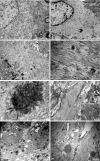Intracellular fibril formation, calcification, and enrichment of chaperones, cytoskeletal, and intermediate filament proteins in the adult hippocampus CA1 following neonatal exposure to the nonprotein amino acid BMAA
- PMID: 24798087
- PMCID: PMC4335130
- DOI: 10.1007/s00204-014-1262-2
Intracellular fibril formation, calcification, and enrichment of chaperones, cytoskeletal, and intermediate filament proteins in the adult hippocampus CA1 following neonatal exposure to the nonprotein amino acid BMAA
Abstract
The environmental neurotoxin β-N-methylamino-L-alanine (BMAA) has been implicated in the etiology of neurodegenerative disease, and recent studies indicate that BMAA can be misincorporated into proteins. BMAA is a developmental neurotoxicant that can induce long-term learning and memory deficits, as well as regionally restricted neuronal degeneration and mineralization in the hippocampal CA1. The aim of the study was to characterize long-term changes (2 weeks to 6 months) further in the brain of adult rats treated neonatally (postnatal days 9-10) with BMAA (460 mg/kg) using immunohistochemistry (IHC), transmission electron microscopy, and laser capture microdissection followed by LC-MS/MS for proteomic analysis. The histological examination demonstrated progressive neurodegenerative changes, astrogliosis, microglial activation, and calcification in the hippocampal CA1 3-6 months after exposure. The IHC showed an increased staining for α-synuclein and ubiquitin in the area. The ultrastructural examination revealed intracellular deposition of abundant bundles of closely packed parallel fibrils in neurons, axons, and astrocytes of the CA1. Proteomic analysis of the affected site demonstrated an enrichment of chaperones (e.g., clusterin, GRP-78), cytoskeletal and intermediate filament proteins, and proteins involved in the antioxidant defense system. Several of the most enriched proteins (plectin, glial fibrillar acidic protein, vimentin, Hsp 27, and ubiquitin) are known to form complex astrocytic inclusions, so-called Rosenthal fibers, in the neurodegenerative disorder Alexander disease. In addition, TDP-43 and the negative regulator of autophagy, GLIPR-2, were exclusively detected. The present study demonstrates that neonatal exposure to BMAA may offer a novel model for the study of hippocampal fibril formation in vivo.
Figures




Similar articles
-
High resolution metabolite imaging in the hippocampus following neonatal exposure to the environmental toxin BMAA using ToF-SIMS.ACS Chem Neurosci. 2014 Jul 16;5(7):568-75. doi: 10.1021/cn500039b. Epub 2014 May 9. ACS Chem Neurosci. 2014. PMID: 24779349 Free PMC article.
-
MALDI imaging delineates hippocampal glycosphingolipid changes associated with neurotoxin induced proteopathy following neonatal BMAA exposure.Biochim Biophys Acta Proteins Proteom. 2017 Jul;1865(7):740-746. doi: 10.1016/j.bbapap.2016.12.004. Epub 2016 Dec 9. Biochim Biophys Acta Proteins Proteom. 2017. PMID: 27956354 Free PMC article.
-
Neonatal exposure to the cyanobacterial toxin BMAA induces changes in protein expression and neurodegeneration in adult hippocampus.Toxicol Sci. 2012 Dec;130(2):391-404. doi: 10.1093/toxsci/kfs241. Epub 2012 Aug 7. Toxicol Sci. 2012. PMID: 22872059 Free PMC article.
-
Mechanisms of beta-N-methylamino-L-alanine induced neurotoxicity.Amyotroph Lateral Scler. 2009;10 Suppl 2:56-60. doi: 10.3109/17482960903269062. Amyotroph Lateral Scler. 2009. PMID: 19929733 Review.
-
The Cyanotoxin and Non-protein Amino Acid β-Methylamino-L-Alanine (L-BMAA) in the Food Chain: Incorporation into Proteins and Its Impact on Human Health.Neurotox Res. 2019 Oct;36(3):602-611. doi: 10.1007/s12640-019-00089-9. Epub 2019 Aug 3. Neurotox Res. 2019. PMID: 31377995 Review.
Cited by
-
Environmental Neurotoxin β-N-Methylamino-L-alanine (BMAA) as a Widely Occurring Putative Pathogenic Factor in Neurodegenerative Diseases.Microorganisms. 2022 Dec 6;10(12):2418. doi: 10.3390/microorganisms10122418. Microorganisms. 2022. PMID: 36557671 Free PMC article. Review.
-
Zinc binding regulates amyloid-like aggregation of GAPR-1.Biosci Rep. 2019 Feb 12;39(2):BSR20182345. doi: 10.1042/BSR20182345. Print 2019 Feb 28. Biosci Rep. 2019. PMID: 30700571 Free PMC article.
-
Dietary exposure to an environmental toxin triggers neurofibrillary tangles and amyloid deposits in the brain.Proc Biol Sci. 2016 Jan 27;283(1823):20152397. doi: 10.1098/rspb.2015.2397. Proc Biol Sci. 2016. PMID: 26791617 Free PMC article.
-
Mitotically heritable effects of BMAA on striatal neural stem cell proliferation and differentiation.Cell Death Dis. 2019 Jun 17;10(7):478. doi: 10.1038/s41419-019-1710-2. Cell Death Dis. 2019. PMID: 31209203 Free PMC article.
-
High resolution metabolite imaging in the hippocampus following neonatal exposure to the environmental toxin BMAA using ToF-SIMS.ACS Chem Neurosci. 2014 Jul 16;5(7):568-75. doi: 10.1021/cn500039b. Epub 2014 May 9. ACS Chem Neurosci. 2014. PMID: 24779349 Free PMC article.
References
Publication types
MeSH terms
Substances
LinkOut - more resources
Full Text Sources
Other Literature Sources
Miscellaneous

